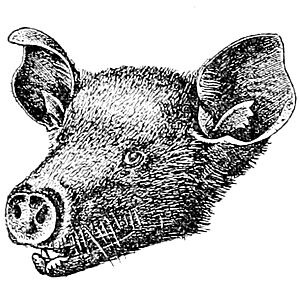Jamaican flower bat facts for kids
Quick facts for kids Jamaican flower bat |
|
|---|---|
 |
|
| Conservation status | |
| Scientific classification | |
| Genus: |
Phyllonycteris
|
| Species: |
aphylla
|
 |
|
The Jamaican flower bat (Phyllonycteris aphylla) is a special type of bat. It lives only in Jamaica. Sadly, it is a critically endangered species, meaning it's at a very high risk of disappearing forever.
Contents
Discovering the Jamaican Flower Bat
An American scientist named Gerrit Smith Miller Jr. first described this bat in 1898. He gave it the scientific name Phyllonycteris aphylla. The word aphylla comes from an Ancient Greek word meaning "leafless." This name probably refers to its small nose-leaf.
What Does the Jamaican Flower Bat Look Like?
This bat is quite small. It weighs about 14 to 18 grams, which is like weighing a few grapes. Its whole body is about 88 millimeters long, or about 3.5 inches. Its forearm is about 48 millimeters long. The skin on its forearm is pink.
Its ears are about 16 millimeters long and 12 millimeters wide. Inside its ear, there's a small flap called a tragus, which is about 8 millimeters long.
The Jamaican flower bat has a simple, disc-shaped nose-leaf at the end of its snout. Its fur is short and feels silky. The hairs on its back are about 6 millimeters long. The hairs on its belly are a bit shorter, about 4 millimeters long.
Its feet are quite large for its body size, about 17 millimeters long. The skin between its legs, called the uropatagium, does not have a special spur. Like other bats in its group, it has a long tongue. This tongue has tiny bumps on it, which help it eat.
The fur on its back is blond or light gold. Its belly fur is almost white. The membranes it uses for flying are dark brown or almost black.
Life and Habits of the Jamaican Flower Bat
The Jamaican flower bat is a social animal. It lives in large groups called colonies. These colonies can have hundreds of bats. Sometimes, different types of bats live together in the same colony.
These bats absolutely need caves to live in. They use caves for sleeping and raising their young. Without caves, they cannot survive.
Scientists don't know much about how these bats reproduce. However, one report from 1970 mentioned finding a pregnant female bat in January.
The Jamaican flower bat eats different kinds of food. It enjoys fruit, pollen, and nectar from flowers. It might also eat insects. In 1965, a female bat was kept in a special place for a month. She ate bananas, papayas, mangoes, and fruit nectar.
Where Do Jamaican Flower Bats Live?
This bat species is found only on the island of Jamaica. Currently, scientists know of only two caves where these bats live: Marta Tick Cave and Stony Hill Cave.
In the past, a very large colony of these bats lived in St. Clair Cave. This was the only known large group for this species. However, the Jamaican flower bat no longer lives there.
Older reports from 1970 suggested the bat could be found in three other caves: St. Clair Cave, Riverhead Cave, and Mt. Plenty Cave. Scientists have also found old bat remains in Wallingford and Runaway Bay Caves.
Protecting the Jamaican Flower Bat
Since 2015, the IUCN has listed the Jamaican flower bat as critically endangered. This means it faces a very high risk of extinction.
Here's why it's in so much trouble:
- It lives in only two known caves.
- The total number of these bats is estimated to be fewer than 250 individuals.
- Each group of bats has fewer than 50 individuals.
- The number of bats is likely decreasing.
The Jamaican flower bat used to live in five or six caves. Now, it lives in only two. One reason for its decline in St. Clair Cave might be feral cats. These cats live in the cave and hunt bats.
The area where these bats live is very small, about 400 square kilometers. From 2008 to 2015, the IUCN had listed this species as "least concern." This was the lowest risk level for extinction. Now, the biggest threat to these bats is people disturbing their caves.


